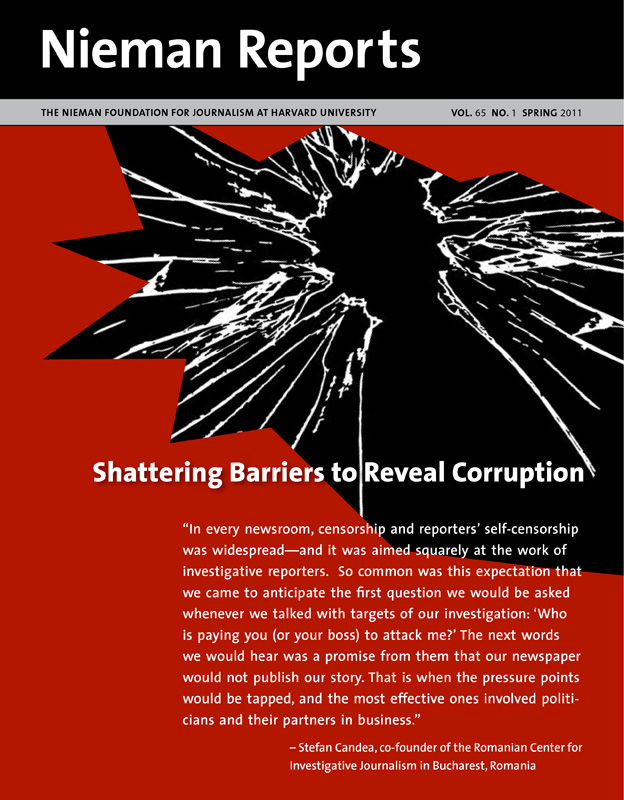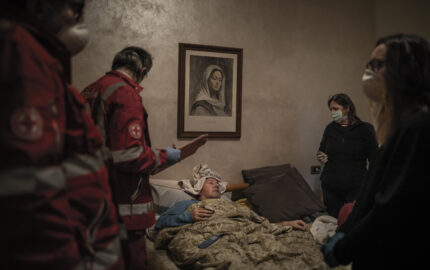
It's been 20 years since the global dissemination of the "Russian" mafias, and this is a topic I've covered as an investigative reporter for 15 of those years. As I review some of my notes from these years, I am left to wonder how I once could have asserted that the threat is behind us—that the European Union and even the United States had survived the vory v zakone, the criminals who emerged out of the old Soviet Union and obtained a high status of authority and power. Now I am not that sure anymore.
One particular moment keeps buzzing in my head: July 17, 1998. That Friday, in the middle of the high-security diamond district in Antwerp, Belgium, a killer who has never been caught or even identified fired seven bullets—one in the head, six others in the torso, from behind—into one of my best sources. Rachmiel Brandwain, who was 49 years old, had been one of the main money launderers for Russian and Eastern European mafias. With his help, I had discovered how Burmese heroin was coming to New York, on whose orders Lithuanian journalists were slaughtered, and how the Red Army's budget was siphoned out of the Kremlin through weapons, cigarettes and vodka.
On that day I understood, through blood and fear, how five years of press investigations had enraged the Russian mafias. To commit such a cold-blooded murder in the heart of Western Europe meant they were in the highest state of alarm. What I didn't comprehend at that time was that the criminal avtoritets ("authorities") that we were branding "Russians"—coming from Moscow but also Warsaw, Poland and Kiev, Ukraine—were already fighting gangs from Lithuania, Albania, Kosovo, Chechnya and even Kazakhstan to maintain a tight grip on the Western European criminal markets. In fact, this second wave of organized crime was already in business: The head of the Kazakh gang had just established himself in Waterloo, Belgium and at the hand of the so-called Lithuanian "devils" thousands of luxury cars were disappearing as mechanics dismantled three to four cars per night.
No longer was I a reporter within a triumphant Europe: I was now embedded in a circumstance of continental resistance. This left me no choice but to become a "foreign" correspondent working on the multiple fronts of this war that numerous Eastern Europe journalists had been covering for so long. Morally, I had no other choice but to enlist my newspaper to cover this story and allocate our budget to this effort.
In 2004, I watched with delight as the E.U. brought in Lithuania, Poland and Hungary. I recognized that the inclusion of these countries was the only way to root out the Soviet-style mafias who held such power. Then came 2007, when the E.U. opened its doors to Bulgaria and Romania, and I'm still wondering if it didn't try then to build a bridge too far. But was there any other choice?
Don't get me wrong. I never had faith that the press would be able to play a decisive role in the diminishment of organized crime. As I followed the trail of heroin during these last two years, I saw how the Bulgarian mafia can send its own trucks to collect Afghan opiates—they can reach as far as Sistan-Baluchestan in eastern Iran. When I saw that, I lost any illusion I might have had of an easy victory.
But in 2011, I am still astonished when new sources come to me in Brussels, among them Chechen refugees who are former fighters of the first Chechen war (1994-96), complaining about the return to Western Europe of a new generation of Chechen killers and loan sharks. This most recent wave of criminals is not working for the Russian mafia; they work for the pro-Russian regime in Grozny, the capital of Chechnya. And if they do not dare to sleep in Warsaw, Poland anymore, they do stay as close as Minsk, Belarus.
In the eyes of their victims, I see the same despair as I did 20 years ago. I also find a common thread between the purely criminal slaughters of the 1990's and the assassinations of journalist Anna Politkovskaya in Moscow in 2006; Umar S. Israilov, a former bodyguard to the Chechen president who later accused him of kidnapping and torture, in Vienna in 2009; and journalist Zarema Sadulayeva in Grozny, also in 2009. It left me wondering whether this means that all of the stories I have done—and those done by a battalion of Russian and Eastern European journalists—have produced any positive and sustainable results.
The Lithuanian Saga
Since 1994, I've been back and forth to Lithuania many times. This country offers a wonderful narrative that illustrates this dramatic plot, beginning with the dark times of October 1993. It was then that the Vilnius Brigade, the dominant mafia group in Lithuania, killed at point-blank range Vitas Lingys, the 33-year-old deputy editor of Respublika newspaper. So huge was the shock that the presumed godfather of the brigade, Boris Dekanidze, was arrested and sentenced in 1994 and executed the following year.
In the aftermath of this event, I could see that the press were finding their muscles and independence, and in Vilnius, the capital, as well as the countryside I started to hear support for democracy. Local newspapers, such as Kauno Diena ("Kaunas Daily") in Kaunas, were publishing every bit of information they had on the local mafia heads, even in the face of direct threats. At the same time, I saw a new generation of policemen and magistrates. They might have had private ambitions but their goal was to reach a Western European standard of quality. They did so with their investigations—using wiretaps and undercover operations—that have been challenged in Western Europe by the mafia lawyers.
This investigative energy represents the golden side of this coin: Police investigations were valid, and legal systems were in place in Lithuania; this permitted local journalists to believe they would be protected as they produced new revelations. But there is a more somber side: In 1996, less than one year after the "beheading" of the Vilnius Brigade, a new criminal network emerged. Members of the Daktarai gang came out of the former Soviet Union's re-education camps and again turned their assaults on Western Europe.
This is where the story gets murky. In response to this second wave of mafia activity, the Western press proved itself to be quite weak. As the new century started, I recall writing that judicial cooperation between Eastern and Western Europe had improved, but the budgets of our police forces were shrinking. I realize now that our newsrooms were experiencing a similar situation; while we had established better channels of communication with colleagues in Eastern Europe, our budgets to support this kind of reporting were vanishing. Since 2001, every euro left in our newsroom was spent on covering terrorism and the wars in Afghanistan and Iraq. (I must admit I was one of the first to temporarily neglect mafia coverage and fly repeatedly to Kabul and Fallujah.) Since 2006, we have not even been able to keep that minimal pace.
East Meets West
Then came something even worse—the short attention span of readers consumed by buzz and infotainment. Mafia coverage requires too many names to be remembered. These stories are perceived as being too complex, and with their evolving structures the connections can be very difficult to map. The budget needed to do these lengthy investigations is huge because human intelligence—the need to find and work with challenging sources—is such a key factor to success. Finally, these stories pose a legal (and consequently a potential financial) risk of killing a newsroom.
These stories were simply too expensive to undertake and too hard to sell: How do you tweet mafia stories? Suddenly I realized that our Western newsrooms—though we knew we were confronted by a new wave of mafias—were suffering some kind of attention deficit hyperactivity disorder resulting from our lack of money and a loss of our deep commitment to such stories. It was a terrible time for this to be happening; after all, a new generation of investigative journalists—financed and coached by many of us during training sessions in the 1990's—was emerging in Eastern Europe. These were precisely the new editorial partners that we had been craving 10 years before—like the Center for Investigative Reporting in Bosnia or the Romanian Center for Investigative Journalism in Bucharest. They needed us as partners for future investigations, and we were unable to follow through. In the name of Western European newsrooms, I think we owe them an apology.
I do not foresee any improvement before 2015 due to the structures of our Western European newsrooms. No newspaper will fund ambitious cross-border investigations about a particular mafia group and collective funding approaches can be problematic when it comes to organized crime. Nobody wants to fund these stories so for them to be reported we must establish "no budget" networks—with each newsroom covering and exchanging the information it can gather close to home. But for this to happen journalists in the West will need to rediscover flexibility and humility and those in the East have to adjust to working with our quality standards.
Today no Lithuanian newspaper would get a reporter in the West a copy of the judiciary records of its nation's "godfather." If Western journalists want a copy of the Soviet-era indictments and sentences or leaked information from a wiretap, they have to get those themselves. A Lithuanian newsroom likely has the best pictures and direct phone numbers, and reporters there will know the latest rumors. But what is new is that Lithuanian newsrooms are now able to take the lead in a joint investigation and ask Western reporters to jump in. This is a serious improvement.
On the Western side, I also find some reason for hope. After a decade of rebuilding in Western Europe (as well as in Africa and South Asia), we hear again from readers and sources about the activities of these powerful Eastern European mafia groups. They tell us about developments that threaten their serenity. And they do not want us to simply tweet this news. If we are to regain our position as brave firefighters of the daily life, our newsrooms have little choice but to readjust their thinning budgets and become serious once again in their reporting about these mafia groups.
This time we can report hand in hand with our colleagues in Eastern Europe. Perhaps this imperious need to join forces will prove to be an important turning point.
Alain Lallemand is a senior investigative reporter at Le Soir ("The Evening") in Brussels and a lecturer in narrative reporting at the University of Louvain in Belgium. He specializes in reporting on organized crime and members of the mafia. During the past decade he has contributed reporting to projects done by the International Consortium of Investigative Journalists.


